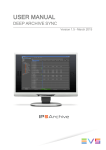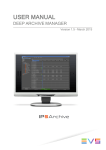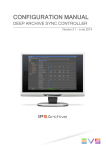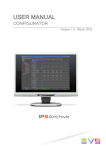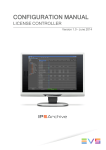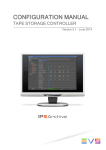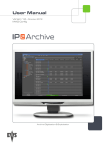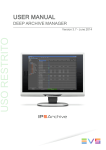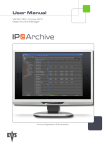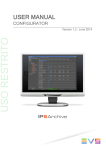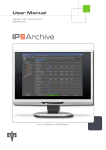Download User Manual - IP2Archive V1.5 Application Monitor V2.1
Transcript
USER MANUAL APPLICATION MONITOR Version 1.5 - March 2015 USER MANUAL IP2Archive 1.5 Application Monitor Disclaimer This manual and the information contained herein are the sole property of EVS Broadcast Equipment SA and/or its affiliates (EVS) and are provided “as is” without any expressed or implied warranties, including, but not limited to, the implied warranties of merchantability and fitness for a particular purpose. In particular, EVS makes no warranty regarding the use or the consequences of use of this manual and the information contained herein. Furthermore, EVS may not be held liable for any direct or indirect, incidental, punitive or consequential loss, damage, cost or expense of any kind whatsoever and howsoever resulting from the normal or abnormal use of this manual and the information contained herein, even if advised of the possibility of such loss, damage, cost or expense. While every effort has been made to ensure that the information contained in this manual is accurate, up-to-date and reliable, EVS cannot be held liable for inaccuracies or errors that may appear in this publication. The information in this manual is furnished for informational purpose and use only and subject to change without notice. This manual cancels and replaces any previous versions thereof. Copyright Copyright © 2003-2015 EVS Broadcast Equipment SA. All rights reserved. This manual may not be reproduced, transcribed, stored (in a database or an retrieval system), translated into any language, computer language, transmitted in any form or by any means – electronically, mechanically, printed, photocopied, optically, manually or otherwise – in whole or in part without the prior written consent of EVS. Trademarks All product and brand names are registered trademarks and trademarks of EVS or of their respective owners. Improvement Requests Your comments will help us improve the quality of the user documentation. Please send improvement requests, or report any error or inaccuracy on this user manual by e-mail to [email protected]. Regional Contacts You will find the full list of addresses and phone numbers on the following webpage: http://www.evs.com/contacts. I EVS Broadcast Equipment SA Issue 1.5.D - March 2015 User Manuals on EVS Website The latest version of the user manual, if any, and other user manuals on EVS products can be found on the EVS download center, on the following webpage: http://www.evs.com/downloadcenter. II USER MANUAL IP2Archive 1.5 Application Monitor Table of Contents TABLE OF CONTENTS WHAT'S NEW? III 1. ABOUT THE APPLICATION 1 2. INSTALLING THE APPLICATION 2 3. STARTING THE APPLICATION 2 3.1. After Installation 2 3.2. After Configuration 3 3.3. Version and License Check 5 4. 7 USER INTERFACE 4.1. Main Window 7 4.2. Applications Pane 9 4.3. Tasks Pane 5. MONITORING APPLICATIONS AND DATABASE JOBS 10 11 5.1. Application and Database Job Status 11 5.2. Application Task Status 11 5.3. Modifying the Name of Applications and Database Jobs 12 5.4. Enabling Alerts 13 6. MANAGING GRIDS 16 6.1. Introduction 16 6.2. Manipulating Columns 16 6.2.1. Adjusting the Width of Columns 16 6.2.2. Reordering Columns 16 6.3. Copying Data 18 6.4. Sorting Data 18 6.5. Filtering Data 19 7. 6.5.1. Filtering by Values From a Column 19 6.5.2. Filtering by Criteria 20 CONFIGURING THE APPLICATION 7.1. Settings Window Table of Contents I 23 23 I EVS Broadcast Equipment SA 7.2. User Settings 25 7.2.1. Overview User Settings Subcategories 25 7.2.2. General Tab 25 7.3. Global Settings 25 7.3.1. Overview Global Settings Subcategories 25 7.3.2. General Tab 26 7.4. System Settings II Issue 1.5.D - March 2015 27 7.4.1. Overview System Settings Subcategories 27 7.4.2. General Tab 27 7.4.3. Oracle Connection Tab 28 Table of Contents USER MANUAL IP2Archive 1.5 Application Monitor What's New? In the User Manual the icon has been added on the left margin to highlight information on new and updated features. The changes linked to new features in version 2.1 are listed below. Application Monitor now writes files to the AppData folder instead of it's own executable folder. What's New? III USER MANUAL IP2Archive 1.5 Application Monitor 1. About the Application Application Monitor is used in the IP2Archive setup to monitor the status of the (automatic) IP2Archive applications and their tasks and also the status of particular database jobs. 1. About the Application 1 EVS Broadcast Equipment SA 2. Issue 1.5.D - March 2015 Installing the Application See the IP2Archive Installation manual for more information on how to install the application. 3. Starting the Application 3.1. After Installation To start the application after installation, proceed as follows: 1. Double-click the Application Monitor icon on the server desktop to start the application. You can also launch the application by double-clicking the executable file (.exe) in the installation folder. The application splash screen appears while the application logs into the IP2Archive database. Then, the Settings window appears allowing you to configure the application. See section "Configuring the Application" on page "23". 2 2. Installing the Application USER MANUAL IP2Archive 1.5 Application Monitor 3.2. After Configuration To start the application after it has been configured, proceed as follows: 1. Double-click the Application Monitor icon on the server desktop to start the application. You can also launch the application by double-clicking the executable file (.exe) in the installation folder. The application splash screen appears while the application logs into the IP2Archive database. Then, a Login dialog box appears. To be able to log into the application, you need to belong to a user group that has a role which allows to use the application. 2. Enter your username and password and click Login. The main window of the application opens. You get an error notification if: • you have entered a wrong username or password. 3. Starting the Application 3 EVS Broadcast Equipment SA 4 • you have omitted your username. • you have insufficient user rights. • your user account has expired. Issue 1.5.D - March 2015 3. Starting the Application USER MANUAL IP2Archive 1.5 Application Monitor 3.3. Version and License Check Introduction The version of the application and the validity of the application license will be checked when the application logs into the IP2Archive database at startup. The status of the version or the license that is returned is displayed on the application splash screen. Version and License Statuses The following version and license statuses can be returned: Status Description Color Action Required Current The actual version of the application. no color No action required. The application starts automatically. Outdated A newer version of the application exists, but this version can still be used. red By default, the application starts automatically after 10 seconds. The application version that should be installed is displayed. Obsolete A newer version of the application exists and must be used. This version may not be used anymore. Click OK to start the application at once. red Click OK to continue. The application shuts down. The application version that should be installed is displayed. Undefined The version of the application is not defined in the IP2Archivedatabase. black Click OK to continue. The application shuts down. Beta A test version. blue Click OK to start the application. By default, the application starts automatically after 10 seconds. 3. Starting the Application 5 EVS Broadcast Equipment SA Issue 1.5.D - March 2015 Status Description Color License About to Expire The license period is about to expire. It is shown in how many days the license will expire. orange Click OK to start the application at once. By default, the application starts automatically after 10 seconds. Contact your system administrator or check the License Controller manual. License Expired The license period has expired. The date when the license expired is displayed. Action Required red Click OK to continue. The application shuts down. Contact your system administrator or check the License Controller manual. No Valid License There was no valid license found in the database. red The application shuts down. Contact your system administrator or check the License Controller manual. Maximum Licenses Reached The maximum number of instances <NUMBER OF LICENSES> for the license has been reached. Click OK to continue. red Click OK to continue. The application shuts down. Contact your system administrator or check the License Controller manual. 6 3. Starting the Application USER MANUAL IP2Archive 1.5 Application Monitor 4. User Interface 4.1. Main Window General Description The main window gives you an overview of the (automatic) IP2Archive applications and database jobs whose status is monitored by Application Monitor. Area Description The table below describes the various parts of the main window: Part 4. User Interface Name Description 1. Menu bar The menu bar contains three menus: File, Settings and Help. 2. Applications pane The Applications pane displays the (automatic) IP2Archive applications and database jobs in the IP2Archive setup whose status is monitored by Application Monitor. See section "Applications Pane" on page "9". 3. Tasks pane The Tasks pane displays the tasks of the IP2Archive application selected in the Applications pane. See section "Tasks Pane" on page "10". 7 EVS Broadcast Equipment SA Issue 1.5.D - March 2015 Menu Bar The menu bar contains three menus: File, Settings and Help. File Menu The File menu contains two commands: Logout and Exit. Click the File menu or use the keyboard shortcut keys ALT + F or F10 + F to open it. Click Exit or use the keyboard shortcut key X to exit the application. Click Logout or use the keyboard shortcut key O to log out of the application. Settings Menu The Settings menu does not contain any commands. It immediately gives access to the application settings. Click the Settings menu or use the keyboard shortcut keys ALT + S or F10 + S to access the settings. Help Menu The Help menu contains the following commands: Help, Context-Sensitive Help and About. With the Help command you can open the application help file. With the Context-Sensitive Help command you can turn on or off the context-sensitive help mode. In context-sensitive help mode, when you click a user interface item, help for that item is displayed. You can also turn on or off context-sensitive help mode by pressing F1. With the About command the application about box can be opened. The about box displays the application software version, the date until which the application license is valid, the name and version of the database the application is logged on to and the login name used. Click About or use the keyboard shortcut key A to open the application about box. 8 4. User Interface USER MANUAL IP2Archive 1.5 Application Monitor 4.2. Applications Pane General Description The Applications pane displays the (automatic) IP2Archive applications and database jobs in the IP2Archive setup that are monitored. Note that the applications and database jobs displayed in the screenshot below might differ slightly from the ones in your specific setup. Application and Database Job Information Of each application and database job the following information is displayed: Column Description Application The name of the application instance or database job. Machine Name The name of the machine on which the application instance or database job is installed. Machine Description The description of the machine on which the application instance or database job is installed. Path The path of the application's executable file. Status The status of the application or database job. See section "Application and Database Job Status" on page "11". Last Update The date and time the status of the application or database job was last updated in Application Monitor. Alerts The indication that an alert or notification will be sent when the application or database job is not responding or when an error has occurred. The button used to open a configuration screen allowing you to enter a name for the application or database job and to enable and configure the sending of alerts. See section "Enabling Alerts" on page "13". 4. User Interface 9 EVS Broadcast Equipment SA Issue 1.5.D - March 2015 If you select an application, the tasks performed by that application will be displayed in the Tasks pane below. See section "Tasks Pane" on page "10". You can add, modify or remove a description of a particular machine in the settings. See section "General Tab" on page "25" The applications and database jobs are displayed in a grid. Application Monitor has a number of features that allow you to customize the display of the data in the grid. See section "Managing Grids" on page "16". 4.3. Tasks Pane General Description The Tasks pane displays the tasks performed by the application you selected in the Applications pane. A task is an automatic job performed by the application. Each application has one or more tasks. Task Information Of each task the following information is displayed: Column Description Ord. The sequence number of the task. Name The name of the task. Description The description of the task. Status The status of the task.See section "Application Task Status" on page "11". Last Update The date and time the status of the task was last updated in Application Monitor. Def. Act. Indicates if the task is active by default at startup. Active Indicates if the task is currently active. The tasks are displayed in a grid. Application Monitor has a number of features that allow you to customize the display of the data in the grid. See section "Managing Grids" on page "16". 10 4. User Interface USER MANUAL IP2Archive 1.5 Application Monitor 5. Monitoring Applications and Database Jobs 5.1. Application and Database Job Status An application or database job can have one of the following statuses. Status Description Running The application or database job is running as it should. Warning The application or database job reported a warning. Error The application or database job reported an error. Not Responding The application or database job is not responding. Applications and database jobs that are running are highlighted in green. The Application Monitor will highlight the application or database job in red when it cannot report its “healthy” status via the database to the Application Monitor. This happens in the following situations: 5.2. • The application or database job is switched off. • The application or database job has become unresponsive. • The application can no longer connect to the database (Oracle connection lost). • The application or database job got an unexpected error and is able to report this error status. Application Task Status An application task can have one of the following statuses: Status Description Running The task is running as it should. Warning The task reported an warning. Error The task reported an errror. Not Responding The task is not responding. Inactive The task is inactive by default. Inactivated The task is inactivated, but should be active by default. Activated The task is activated, but should be inactive by default. The tasks that are running are highlighted in green. 5. Monitoring Applications and Database Jobs 11 EVS Broadcast Equipment SA Issue 1.5.D - March 2015 The Application Monitor will highlight the task in red when the task cannot report its “healthy” status via the database to the Application Monitor. This happens in the following situations: 5.3. • The task is switched off. • The task has become unresponsive. • The task can no longer connect to the database (Oracle connection lost). • The task got an unexpected error and is able to report this error status. Modifying the Name of Applications and Database Jobs If your IP2Archive setup has various instances of the same application, you can easily make a distinction by manually modifying the name of each instance. You can also modify the name of a database job. To modify the name of an application instance or database job, proceed as follows: 1. Click the Configure Application button job. of the respective application or database The Configure Application dialog box appears. In the Application area, the Name field displays the name of the application instance or database job as set in the IP2Archive database. 2. Modify the name and click the Save button. The name of the application instance or database job will be changed in the IP2Archive database and also in the Applications pane. 12 5. Monitoring Applications and Database Jobs USER MANUAL IP2Archive 1.5 Application Monitor 5.4. Enabling Alerts Introduction Application Monitor allows you to enable for each monitored automatic application and database job in your IP2Archive setup the automatic sending of alerts. Application Monitor will automatically send an alert when an application, application task or database job no longer responds because of an error or because it has been shut down. Once an alert has been sent for a particular application or database job, Application Monitor will automatically disable the Alerts functionality for this application or database job. This to prevent Application Monitor from sending a new alert every minute. This allows you the time to check and solve the problem. The Alert functionality can either be manually reenabled by you, or you can configure Application Monitor to automatically reenable the Alert functionality after a preset time interval. If the problem gets solved, no alert will be sent anymore. How to Enble Alerts Note The alerts will only be delivered if: • the Mail Controller is running • you have specified the addressees for the alerts in the Global Settings. To enable the Alerts functionality for a particular automatic application or database job, proceed as follows: 1. Click the Configure Application button job. of the respective application or database The Configure Application dialog box appears. 2. (Only for database jobs) In the Allowed Idle Time field, enter the time (in hh:mm:ss) a database job is allowed to be idle before Application Monitor will send an alert. 3. To enable the Alerts functionality, select the Alerts Enabled check box. By default, this option is disabled. 5. Monitoring Applications and Database Jobs 13 EVS Broadcast Equipment SA Issue 1.5.D - March 2015 4. Select: ◦ Automatically Re-enable Alerts After if you want Application Monitor to automatically enable the Alerts functionality again a preset time interval after the Alerts functionality was automatically disabled. If this option is selected and the Alerts functionality is automatically disabled, an extra field will appear displaying the actual time when the Alert functionality was disabled and the actual time when the alert functionality will be re-enabled again. ◦ Alerts Have To Be Re-Enabled Manually if you want to manually re-enable the Alerts functionality after it was automatically disabled. The Tasks pane displays the name and a description of the tasks performed by the application. It also shows how long a particular task is allowed to be idle before Application Monitor will send an alert. Note that for a database job, this pane will be empty. 5. (Only for applications) Modify the allowed idle of the desired tasks by entering a new value in the Allowed Idle Time field. 6. Click Save to store the settings in the database. In the Application pane the Alerts check box will be selected. Sample Alerts Below you will find two sample alerts that are automatically sent when an application or database job is not responding because of an error or because it has been shut down. The first sample alert indicates that on May the 8th at 10 o'clock the application DAC Test was not responding. Since the option Automatically Re-enable Alerts After is selected in the settings, a new alert will be send if the problem is not solved within the preset time interval. Process => Application monitoring Type => Error Timestamp => 08/05/2013 10:18:18 Code => 100 Message => Application DAC Test is in state 'Not responding' If the problem is not solved within 02:00:00 from now, this email will be sent again. 14 5. Monitoring Applications and Database Jobs USER MANUAL IP2Archive 1.5 Application Monitor The second sample alert indicates that on May the 8th at 10 o'clock the application DAC Test was not responding. Since the option Alerts Have To Be Re-Enabled Manually is selected in the settings, a new alert will not be sent, even if the problem is not solved. Process => Application monitoring Type => Error Timestamp => 08/05/2013 10:18:18 Code => 100 Message => Application DAC Test is in state 'Not responding' This e-mail will not be sent again, even if the problem is not solved. 5. Monitoring Applications and Database Jobs 15 EVS Broadcast Equipment SA 6. Managing Grids 6.1. Introduction Issue 1.5.D - March 2015 In Application Monitor most of the data is displayed in grids. Each grid consists of a number of columns containing specific information. Application Monitor provides you a number of features to customize each grid. 6.2. Manipulating Columns 6.2.1. Adjusting the Width of Columns The width of each grid column can be manually or automatically adjusted. How to Manually Adjust the Column Width To manually adjust the width of a particular column, drag the right or left border of the column header until the column has the desired width. To manually change the width of a column to fit its contents, double-click the boundary on the right side of the column header. If you hold your cursor over a column header border, it will change into a double-headed arrow. How to Automatically Adjust the Column Width To automatically adjust the width of a column to fit its contents, right-click the column header, and then select the Best Fit option from the context menu. To automatically adjust the width of all columns to fit their contents, right-click the column header, and then select the Best Fit (all columns) option from the context menu. 6.2.2. Reordering Columns If you want the information in a grid to be displayed in a different order, you can change the position of the columns. There are two ways to reorder columns. 16 6. Managing Grids USER MANUAL IP2Archive 1.5 Application Monitor How to Reorder a Column Using a Drag-And-Drop Action To reorder a column by directly dragging its header, proceed as follows: 1. Click the header of the column you want to move and hold down your left mouse button. 2. Drag the column header to the desired position in the grid. Two arrows will indicate where it is possible to insert the column. A black prohibition sign will indicate where the column cannot be inserted. 3. Release the left mouse button to insert the column. How to Reorder a Column Using the Show/Hide/Move Button You can also reorder the columns of a grid by using the Show/Hide/Move button: 1. Click on the left side of the first column header. A drop-down list containing the headers of the grid columns appears. The column headers are listed in the order in which the columns are displayed in the grid. The first header in the list is the leftmost field in the grid. The columns that are visible in the grid are selected. The headers in the screenshot below can differ from the headers available in your application. 2. Select a header and drag it to the desired position in the list. Green arrows will appear indicating where you can insert the grid. In the grid, the column will be moved to the new position. 6. Managing Grids 17 EVS Broadcast Equipment SA 6.3. Issue 1.5.D - March 2015 Copying Data To copy the data of a particular grid row to the Clipboard, proceed as follows: 1. Select the appropriate row in the grid. 2. Press CTRL +C. 6.4. Sorting Data Each grid can be sorted according to the values in one of the columns. You can sort text (from A-Z or from Z-A), numbers (from low to high or from high to low). How to Sort Data by Clicking a Column Header To sort the data in a particular column, click the column header once to sort the data in ascending order. Click again to sort the data in descending order. An arrow next to the column header indicates the sorting method. sorted in ascending order sorted in descending order How to Sort Data by Using the Context Menu You can also sort the data in a particular column by right-clicking the column header and selecting the desired sorting method from the context menu. To clear the sorting in a particular column, right-click the column header and select the option Clear Sorting from the context menu. 18 6. Managing Grids USER MANUAL IP2Archive 1.5 Application Monitor 6.5. Filtering Data You can filter the data in a grid by using two types of filters: by one or more values from a particular column or by simple or complex criteria. 6.5.1. Filtering by Values From a Column To filter the data in a particular grid by one or more values from a particular column, proceed as follows: 1. Hold your cursor over the header of the column by whose values you want to filter the grid, and then click the filter button. A drop-down list opens containing all the column values. 2. Select the desired values. Only the records that contain one of the selected values are displayed in the grid. At the bottom of the grid a filter bar appears displaying the applied filter. 3. In the filter bar, do one of the following: 6. Managing Grids ◦ Clear the check box next to the filter the filter again. to undo it. Select the check box to apply ◦ Click to undo the filter and close the filter bar. ◦ Click to open a drop-down list containing previously applied filters. ◦ Click Customize to create a complex filter. 19 EVS Broadcast Equipment SA 6.5.2. Issue 1.5.D - March 2015 Filtering by Criteria Filters by criteria can be simple or complex: • Simple filters consist of one or two criteria and one Boolean operator (AND or OR). • Complex filters consist of more than two criteria and more than one Boolean operator (AND, OR, NOT AND and NOT OR). How to Create a Simple Filter To create a simple filter, proceed as follows: 1. Hold your cursor over the header of the desired column, and then click the filter button appearing in the right corner. 2. From the drop-down list, select the option (Custom…). The Custom Filter dialog box appears. Here you can enter the criterion or the two criteria you want to filter the values of the selected column by. 3. Select the desired comparison operator from the first drop-down list. A comparison operator is used in comparison criteria to compare two values. Operators include: ‘equals’, ‘does not equal’, ‘is less than’, ‘is less than or equal to’, ‘is greater than’, ‘is greater than or equal to’, ‘like’, ‘not like’, ‘is blank’ and ‘is not blank’. For example, if you want to filter the values of a column by text that includes a certain word, character or sign, you have to select the comparison operator ‘like’. 4. Enter text in the field next to the first drop-down list. For example, if you want to filter by text that includes the letter ‘S’, type %S%. The % wildcard can substitute for zero or more characters. The _ character can substitute for exactly one character. 20 6. Managing Grids USER MANUAL IP2Archive 1.5 Application Monitor 5. If you want to add a second filter criterion, select the desired Boolean operator. Select: ◦ AND, if both criteria have to be true; ◦ OR, if at least one of the criteria or both have to be true. 6. Select the desired comparison operator from the second drop-down list, and then enter text in the field at the right. 7. Click OK to apply the filter. Only the values matching the entered criterion or criteria will be displayed. How to Create a Complex Filter To create a complex filter, proceed as follows: 1. Apply a simple filter to a grid or filter a grid by selecting one or more values from a list of values. See above. At the bottom of the grid a filter bar appears. 2. In the filter bar, click the Customize button. A dialog box appears that allows you to create complex filters. The criteria of the active filter are displayed in a tree structure. Here you can add extra criteria and change the existing criteria. 3. Do one of the following: • • 6. Managing Grids To add a new criterion, do one of the following: ◦ click the Press the Button to Add a New Condition button; ◦ click the Filter button and select Add Condition; ◦ click next to a criterion and select Add Condition. To change a criterion, do one of the following: ◦ click a column header (green and underlined text) and select another value from the list; ◦ click a comparison operator (dark red and underlined text) and select another value from the list: ‘equals’, ‘does not equal’, ‘is less than’, ‘is less than or equal to’, ‘is greater than’, ‘is greater than or equal to’, ‘like’, ‘not like’, ‘is blank’, ‘is not blank’, ‘between’, ‘not between’, ‘in’, ‘not in’; 21 EVS Broadcast Equipment SA ◦ Issue 1.5.D - March 2015 click the dark blue text on the right of the comparison operator and enter another value. • To delete a criterion, click the Remove Row. • To add a group of criteria, do one of the following: • button to the left of the criterion and select the option ◦ click next to a random criterion and select Add Group; ◦ click the Filter button and select Add Group. To delete all criteria, click the Filter button and select the option Clear All. 4. Do one of the following: ◦ To open an existing complex filter, click Open; ◦ To save the current filter, click Save As; ◦ To confirm the changes and close the dialog box, click OK; ◦ To undo the changes, click Cancel. ◦ To apply the changes, click Apply. At the bottom of the grid a bar appears which displays the components of the complex filter. Note that if you have already created a custom filter in the past, you can reapply it by clicking the current filter or the downward pointing arrow. A drop-down list containing previous filters appears. 22 6. Managing Grids USER MANUAL IP2Archive 1.5 Application Monitor 7. Configuring the Application 7.1. Settings Window Opening the Settings Window The Settings window allows you to configure your application. The first time the application is launched after it has been installed, the Settings window opens automatically. The Settings window can also be accessed through the Settings menu. Overview Setup Categories The settings can be divided into two setup categories. In the Settings window, a tab is provided for each setup category. The table below briefly describes each setup category: Setup Category Description User Settings These settings can be configured by each individual user. System Settings These settings configure the general functioning of the application. They can only be configured by the system administrator. 7. Configuring the Application 23 EVS Broadcast Equipment SA Issue 1.5.D - March 2015 Edit Mode To be able to edit the System settings, you first have to enter a password. To put the Settings window into Edit Mode, proceed as follows: 1. Click the Enter Into Edit Mode button . A dialog box appears. 2. Enter the administrator password and then click OK. The Settings window enters into Edit Mode. Note Certain settings are read-only and cannot be configured. These can only be modified in the Configurator application. Other settings have to be configured locally. Saving Settings A Save button is provided which allows you to immediately save the changes you have made to the settings. With the Cancel button you can discard the changes you have made. 24 7. Configuring the Application USER MANUAL IP2Archive 1.5 Application Monitor 7.2. User Settings 7.2.1. Overview User Settings Subcategories The User settings are divided into the following subcategories: • General For each subcategory a tab is provided. 7.2.2. General Tab The General tab displays the name of the servers on which the (automatic) IP2Archive applications are installed that are monitored by Application Monitor. The names are retrieved from the IP2Archive database. With the Refresh List button you can retrieve the latest information from the IP2Archive database. The list of machines will be updated in its actual state. You can add a description to each server. The description you enter here will appear in the Machine Description column in the Applications pane. See section "Applications Pane" on page "9". 7.3. Global Settings 7.3.1. Overview Global Settings Subcategories The User settings are divided into the following subcategories: • General For each subcategory a tab is provided. 7. Configuring the Application 25 EVS Broadcast Equipment SA 7.3.2. Issue 1.5.D - March 2015 General Tab The General tab allows you to search for and specify the recipients or addressees for the alerts that will be automatically sent by Application Monitor when an application or database job is no longer responding in your IP2Archive setup. See section "Enabling Alerts" on page "13". How to Add an Addressee To add an addressee, proceed as follows: 1. In the Relations pane, search for the contact you want to add as addressee for the automatic alerts. Enter (part of) the name of the contact and/or the company and click the Search button. The companies and contacts that correspond to your query appear in the grid below. The e-mail address of each contact is also displayed. 2. Double-click a contact to add him as addressee for the automatic alerts. The contact is added to the Alerts grid. The Send Mail check box is automatically selected. How to Remove an Addressee To remove an addressee again, do one of the following: 1. Select the contact and click the - sign. OR Double-click the contact. 2. Click OK to confirm your action. 26 7. Configuring the Application USER MANUAL IP2Archive 1.5 Application Monitor 7.4. System Settings 7.4.1. Overview System Settings Subcategories The System settings are divided into the following subcategories: • General • Oracle Connection For each subcategory a tab is provided. 7.4.2. General Tab The General tab lists the IP2Archive applications and database jobs that are installed in your IP2Archivesetup. It enables you to specify which applications, application tasks and database jobs should be monitored by Application Monitor. Note that the applications and database jobs displayed in the screenshot below might differ from the applications in your specific setup. If you select the Visible check box of a particular application, application task or database job, it will appear in the Applications pane of the main window. See section "Applications Pane" on page "9". Application Monitor will check the status of this application, application task or database job. To view the tasks of an application, click 7. Configuring the Application . To hide the tasks again, click . 27 EVS Broadcast Equipment SA 7.4.3. Issue 1.5.D - March 2015 Oracle Connection Tab The Oracle Connection tab allows you to configure the connection with the Oracle database. Entering the Database Name In this field you have to enter the name of the database the application has to connect to. If the Use This Database Name check box is selected, the name of the database will automatically appear in the Oracle login dialog box at start-up. Note that the database name will be automatically entered and the Use This Database Name check box will be automatically selected when you log into the application for the very first time. Entering the Login Name In this field you have to enter a login name. If the Use This Login Name check box is selected, the login name will automatically appear in the Oracle login dialog box at startup. Note that the login name will be automatically entered and the Use This Login Name check box will be automatically selected when you log into the application for the very first time. 28 7. Configuring the Application USER MANUAL IP2Archive 1.5 Application Monitor Entering a Password In this field you have to enter a password. If the Use Auto Login check box is selected, the application automatically logs into the selected database at start-up. The Oracle login dialog box does not appear. Note that the password will be automatically entered and the Use Login check box will be automatically selected when you log into the application for the very first time. Checking Application History By clicking the Application History button, you can open a chronological list of all software versions of the application. To get more details about each version (creation date, name of programmer, status, additional remarks), you have to click + next to the version number. Activating Keep Alive If the option Keep Connection Alive is selected, a message is sent to the database at regular time intervals to avoid idle connections from being closed by the firewall. These intervals can be set by you. Note that this option will be automatically selected when you log into the application for the very first time. If the option Try to Reconnect if Keep Alive Fails is selected, the application will try a number of times to reconnect with the database. If the option Report Status in Database Everytime Keep Alive Timer Triggers is selected, the status of the connection is reported in the database each time the Keep Alive Timer sends a trigger to send a Keep Connection Alive message. Testing the Oracle Connection The Test Oracle button allows you to check the validity of the database name, login and username you entered. If these data are valid, then the following message appears next to the Test Oracle button: ‘OK’. If the login name or password is invalid, then a message box appears with the following message: ‘ORA-01017: invalid username/password; logon denied’. If the database name is invalid, then a message box appears with the following message: ‘ORA-12154:TNS: could not resolve the connect identifier specified’. If you omit the password, then a message box appears with the following message: ‘ORA01005: null password given; logon denied’. If you do not enter a database name, login and username, then a message box appears with the following message: ‘ORA-12560: TNS: protocol adapter error’. 7. Configuring the Application 29 EVS Broadcast Equipment SA Issue 1.5.D - March 2015 You can also check the software version of the application by clicking the Test Oracle button. If the software version is up-to-date, then the following message appears: ‘Current– The Current Version’. If the software version is outdated, then the following message appears: ‘Unknown Version Application! Please contact the EDP department.’ If you close the Settings window without testing the validity of the database name, login and username you just entered, then a message box appears. If you click Yes, then the Settings window is closed and the original values are restored. If you click Cancel, then the Settings window does not close and you can test the values by clicking the Test Oracle button. If you change the current database settings, test the connection and then close the Settings window, a message box will appear. If you click Yes, the application is stopped and closed. A manual restart will be required. Click Cancel to continue. 30 7. Configuring the Application Corporate +32 4 361 7000 North & Latin America +1 973 575 7811 EVS Headquarters Liège Science Park 16, rue Bois St Jean B-4102 Seraing Belgium To learn more about EVS go to www.evs.com Asia & Pacific +852 2914 2501 Other regional offices www.evs.com/contact EVS Broadcast Equipment is continuously adapting and improving its products in accordance with the ever changing requirements of the Broadcast Industry. The data contained herein is therefore subject to change without prior notice. Companies and product names are trademarks or registered trademarks of their respective companies.








































